Discover the 12 best technical documentation templates for 2025. Find free & paid options to streamline your API docs, user manuals, and more.
Creating comprehensive technical documentation from a blank page is an inefficient allocation of engineering resources. A well-chosen framework not only accelerates the process but also enforces consistency, which is critical for scalability and maintainability. Without a standardized structure, teams often produce fragmented, difficult-to-navigate documents that hinder rather than help development, support, and user adoption. This is where a strategic selection of technical documentation templates becomes a mission-critical asset, establishing a single source of truth for complex systems.
This curated list moves beyond generic recommendations to provide an analytical breakdown of the best platforms and resources for generating effective documentation. We will assess 12 leading options, evaluating their specific use cases, from API references and architecture overviews to user guides. A robust documentation framework is crucial not only for internal processes but also for improving the user experience, especially when considering how documentation aids user onboarding best practices.
Each entry in this resource guide includes a detailed analysis, implementation considerations, and an honest look at potential limitations. You will find direct links and screenshots to help you quickly identify the ideal solution for your project’s unique requirements, whether you’re a solo developer, a growing startup, or an established enterprise engineering team. The goal is to equip you with the information needed to select a template that streamlines your workflow and produces clear, functional documentation.
Best for: AI-driven code and API documentation generation.
DocuWriter.ai distinguishes itself as a premier, AI-powered platform that moves beyond static technical documentation templates by automating the entire creation process. Instead of providing a pre-formatted file, it generates high-quality, context-aware documentation directly from your codebase. This automation is a significant advantage for fast-moving development teams struggling to keep documentation synchronized with rapid code changes.
The platform’s core strength lies in its ability to parse code and produce accurate docblocks, code comments, and comprehensive API documentation with minimal human intervention. This saves developers hundreds of hours and ensures a level of consistency that is difficult to achieve manually. For teams needing more than just basic text, DocuWriter.ai offers advanced capabilities that set it apart.
DocuWriter.ai operates on a subscription model, with plans starting at a highly accessible $19/year for the Starter package. However, to unlock its most powerful features, such as advanced integrations (VSCode, n8n) and unlimited access, teams will need to invest in the Professional or Enterprise tiers. While the higher-tier plans represent a significant investment, the return on investment through saved engineering hours and improved code quality is substantial, as echoed by its 22,800+ members. The platform also offers a valuable educational discount, making it accessible to students and academic institutions.
Website: https://www.docuwriter.ai/
MadCap Software provides a suite of professional, pre-built project templates specifically for its powerful authoring tool, MadCap Flare. Unlike standalone template files, these are fully integrated project structures, offering a robust starting point for comprehensive documentation like user manuals, knowledge bases, and policy guides. This platform is geared toward teams seeking an enterprise-grade solution for creating and managing extensive help content.
The primary distinction is its reliance on the MadCap Flare ecosystem. This makes it an all-in-one solution rather than a simple template repository. For teams already invested in or considering Flare, these technical documentation templates accelerate development by providing a polished, functional framework out of the box.
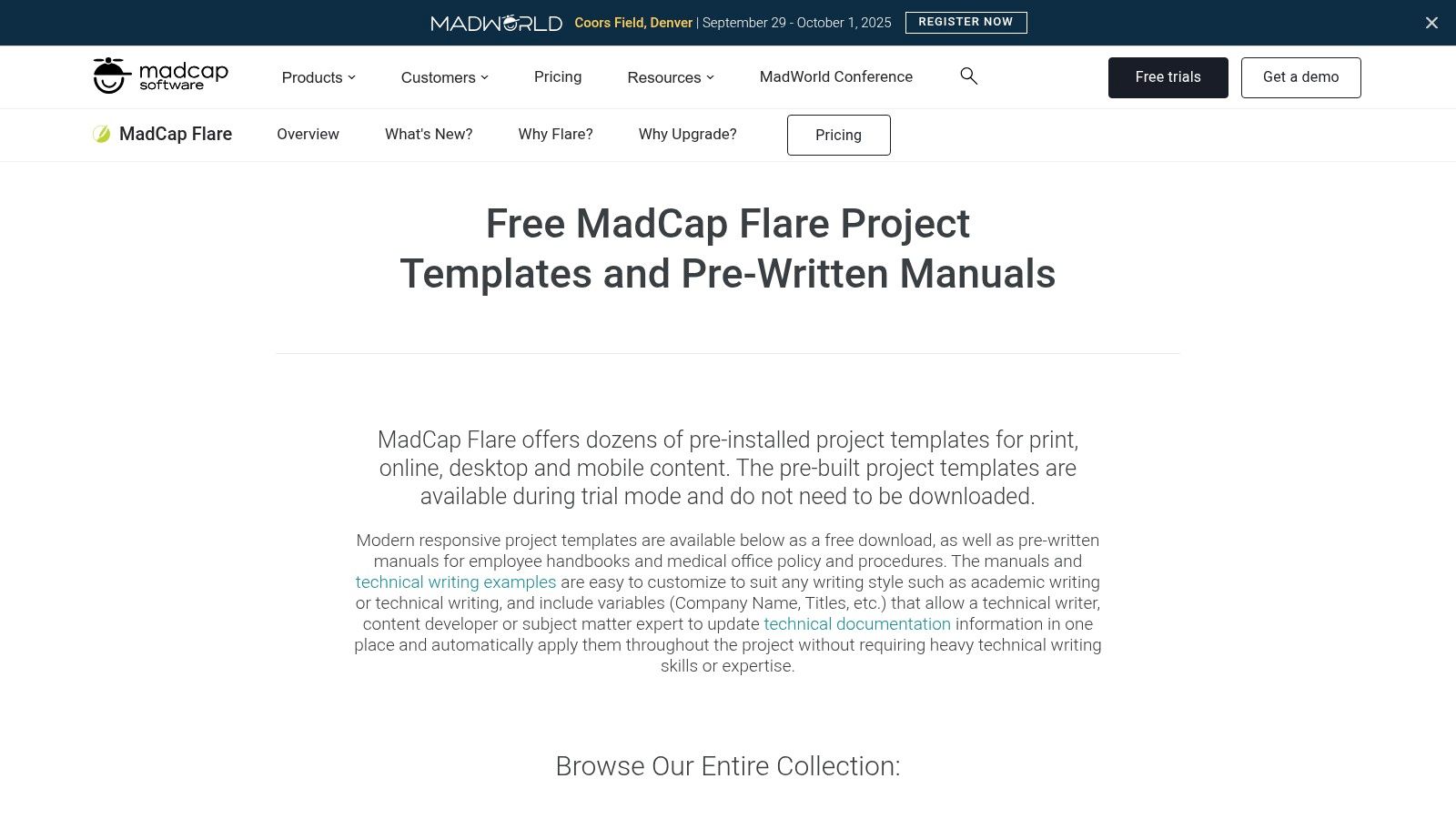
MadCap’s templates are not just visually appealing; they are structurally sound, incorporating best practices for topic-based authoring and single-sourcing. This means you can efficiently reuse content across different outputs, like online help and printable PDFs, from a single project.
Best For:
Implementation Note: To use these templates, you must have a MadCap Flare license, which is a paid subscription. The software itself has a significant learning curve, but the investment pays off for complex documentation needs through powerful features like conditional content, variables, and translation management.
Website: MadCap Flare Project Templates
Scribe specializes in auto-generating process documentation but also provides a library of free, text-based templates for various needs like project, IT, and software documentation. Its core strength lies in its browser extension and desktop app that capture your workflow and automatically create step-by-step guides with text and screenshots. This makes it ideal for teams who need to document internal processes or create user guides quickly.
The platform’s approach shifts the focus from manual writing to automated capture. While it offers traditional templates, its true value is in generating highly visual, step-by-step instructions with minimal effort. This makes Scribe a powerful tool for teams looking to create consistent and clear technical documentation templates for training, support, and standard operating procedures.
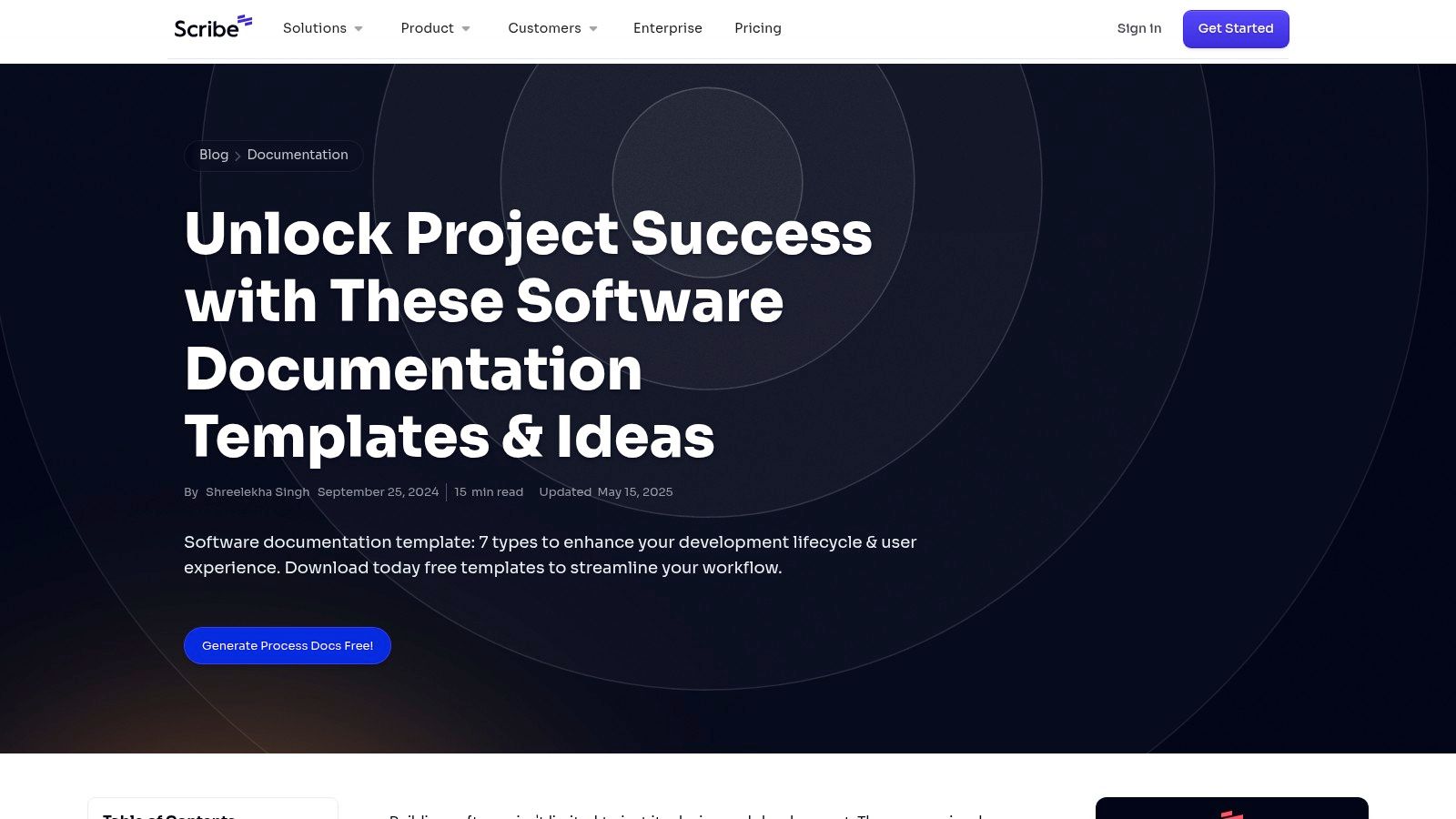
Scribe excels at creating “how-to” documentation. The templates are straightforward and provide a solid structure, but the real power comes from its auto-generation tool, which populates these structures for you. This dramatically reduces the time spent on creating support articles and internal knowledge base content.
Best For:
Implementation Note: The free version is quite capable for individuals and small teams. For advanced features like custom branding, team collaboration, and exporting to formats other than PDF or HTML, a paid Pro plan is required. The learning curve for its core capture feature is virtually nonexistent.
Website: Scribe Software Documentation Templates
ClickUp offers a versatile technical documentation template directly within its project management ecosystem. This approach shifts documentation from a standalone artifact into an integrated part of the development lifecycle. The template provides a structured framework covering product details, features, and troubleshooting, all within a collaborative, real-time environment. This makes it ideal for teams who already manage their workflows in ClickUp and want to keep documentation closely tied to tasks and sprints.
The key differentiator is its native integration with project management functionalities. Unlike dedicated authoring tools, ClickUp’s technical documentation templates live alongside the projects they describe, enabling seamless collaboration and status tracking. This unified approach helps maintain documentation relevance and accuracy throughout a project’s evolution.
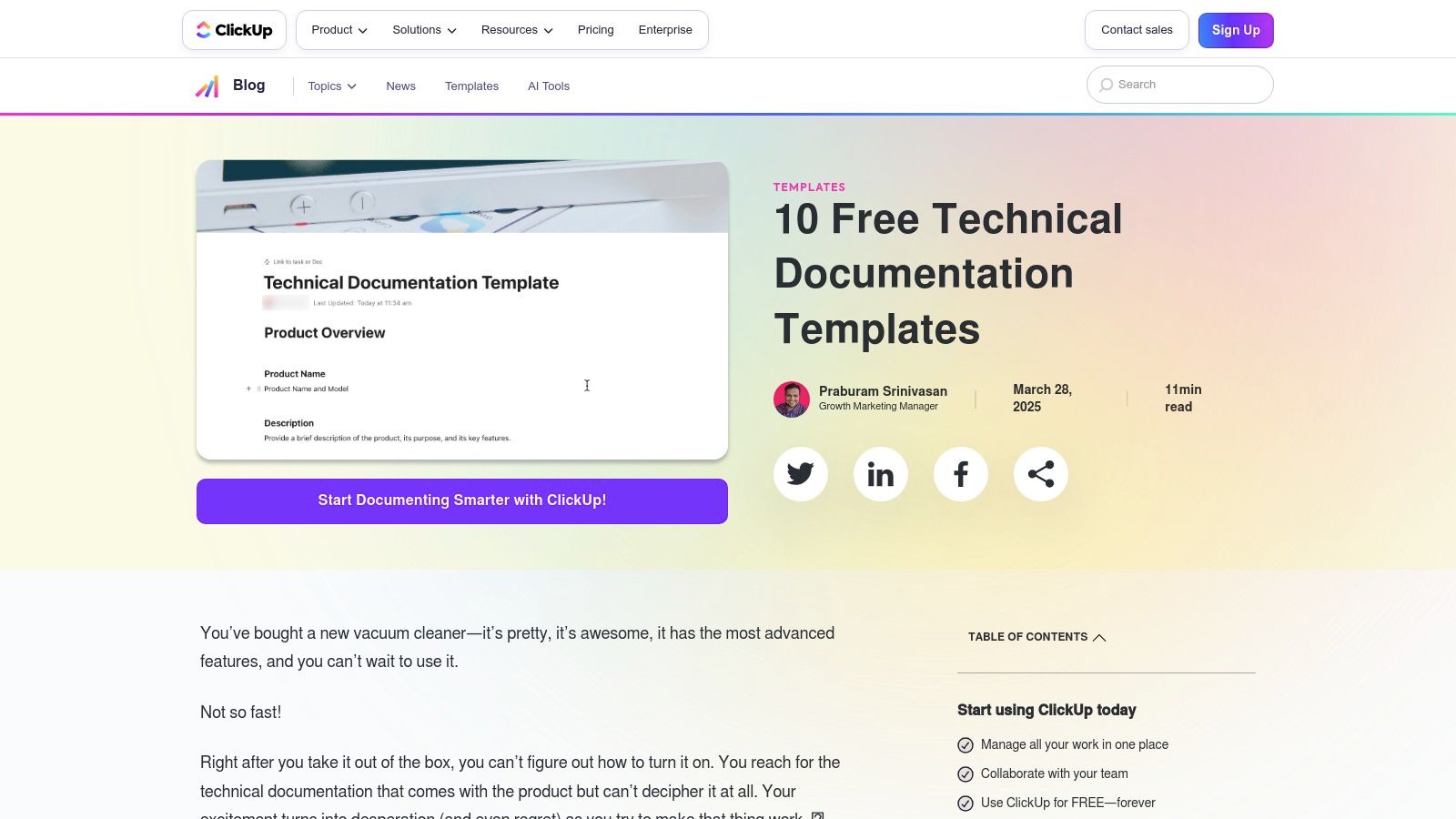
ClickUp’s template is more about workflow and collaboration than advanced formatting. It excels at keeping documentation accessible and actionable for the entire team. The ability to assign comments, link tasks directly to documentation sections, and view document history makes it a dynamic tool for agile environments. For those exploring various platforms that can support documentation workflows, a more detailed comparison of project management tools like ClickUp and Asana can provide deeper insights.
Best For:
Implementation Note: Accessing the template requires a ClickUp account, though it is available on their free plan. While user-friendly, teams new to the platform may face a learning curve in understanding how to best leverage its extensive project management features alongside documentation.
Website: ClickUp Technical Documentation Templates
Bit.ai positions itself as a collaborative document platform, offering a library of interactive templates rather than simple downloadable files. Its strength lies in providing a live, web-based environment where teams can co-create documents like standard operating procedures, API documentation, and software design documents. This platform is ideal for teams seeking a unified workspace to draft, comment on, and share technical content without juggling multiple tools.
The key differentiator for Bit.ai is its focus on “smart” documents. These are not static pages but dynamic workspaces that can embed rich media, code blocks, and other interactive elements directly. This makes the platform’s technical documentation templates more than just a starting point; they are a complete, collaborative authoring environment.
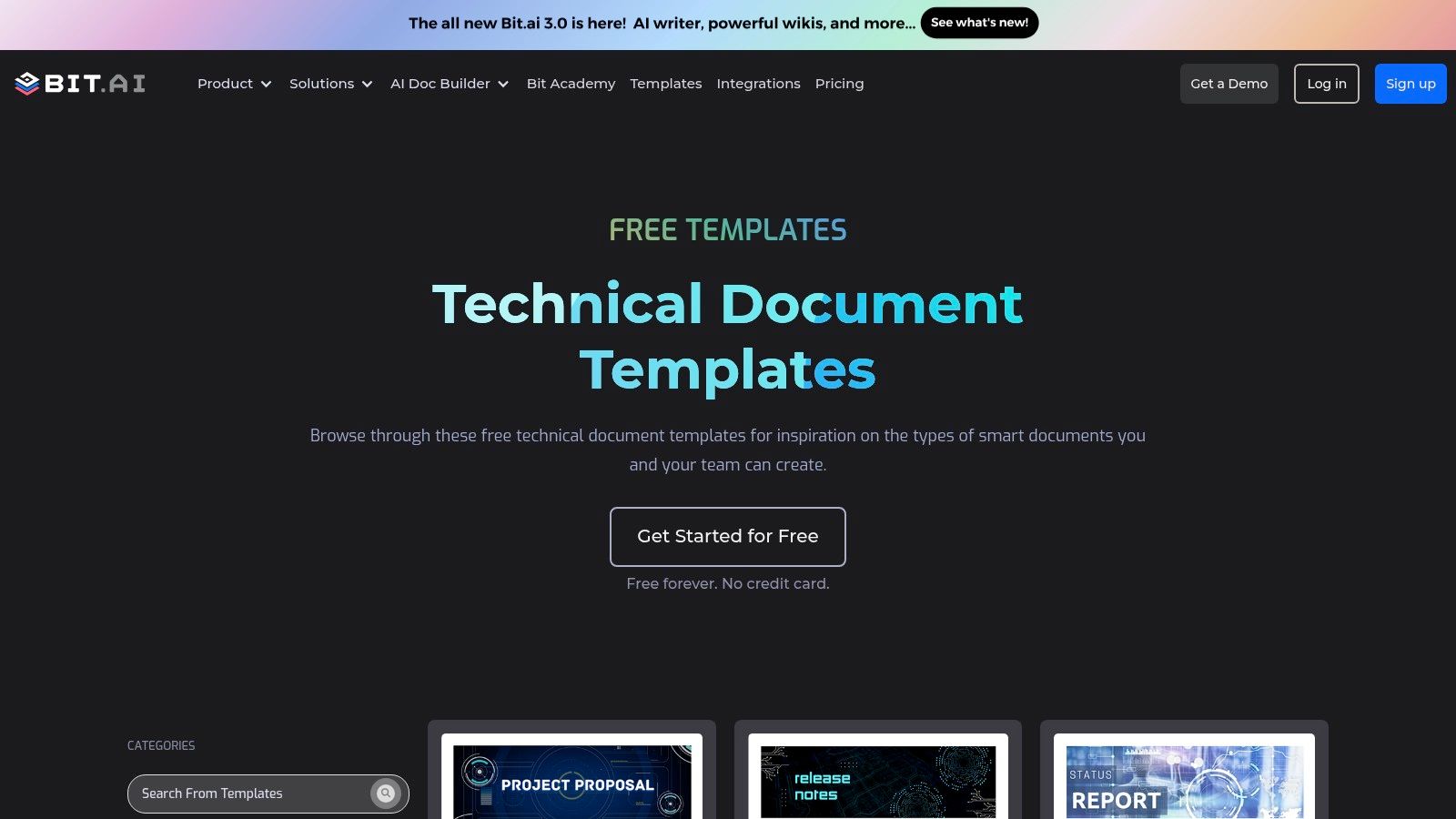
Bit.ai’s templates are designed for immediate use and real-time teamwork, making them highly effective for agile teams. The interface is clean and user-friendly, lowering the barrier to entry for non-technical contributors who may need to participate in the documentation process. The platform’s robust editor and commenting features streamline the review and approval workflow significantly.
Best For:
Implementation Note: While the templates are free to use, they are intrinsically tied to the Bit.ai ecosystem. You must create an account to access and edit them. The free plan has limitations, with paid tiers offering more advanced features, storage, and guest access.
Website: Bit.ai Technical Templates
The Technical Writing Process website provides a collection of professional, methodology-driven templates for technical writers. Unlike repositories that focus solely on the final document’s appearance, these resources are designed to structure the entire documentation workflow, from planning and audience analysis to final review. They are offered in familiar Microsoft Office formats (Word, Excel, PowerPoint, Visio), making them highly accessible for teams that rely on this ecosystem.
These templates stand out by embedding a structured methodology directly into the documents. For instance, a user guide template might include sections for defining personas and use cases, not just chapter layouts. This makes these technical documentation templates invaluable for teams looking to formalize their procedures and ensure comprehensive, consistent outputs across all projects.
The strength of these templates lies in their procedural guidance. They act as a checklist and framework, guiding the writer through essential steps often overlooked in rush projects. This process-oriented approach promotes higher-quality documentation by enforcing best practices from the start. To learn more about how this aligns with industry standards, you can review this guide to software documentation best practices.
Best For:
Implementation Note: The templates are sold individually or in bundles as paid products. While they are built on Microsoft Office, users should expect to adapt them to fit their specific project requirements, branding, and style guides.
Website: Technical Writing Process Templates
Asana, a leading project management platform, offers a free technical documentation template that shifts the focus from standalone documents to integrated, collaborative workflows. Instead of a downloadable file, Asana’s template is a pre-configured project within its own ecosystem. This approach is designed for teams that need to manage documentation as an ongoing, actionable part of their development cycle, tying tasks directly to content creation and updates.
The core strength of this offering is its seamless integration with project management. This makes it a unique choice for teams already using or considering Asana for task tracking. These technical documentation templates are less about final polish and more about process efficiency, ensuring documentation keeps pace with development sprints and team-wide communication.
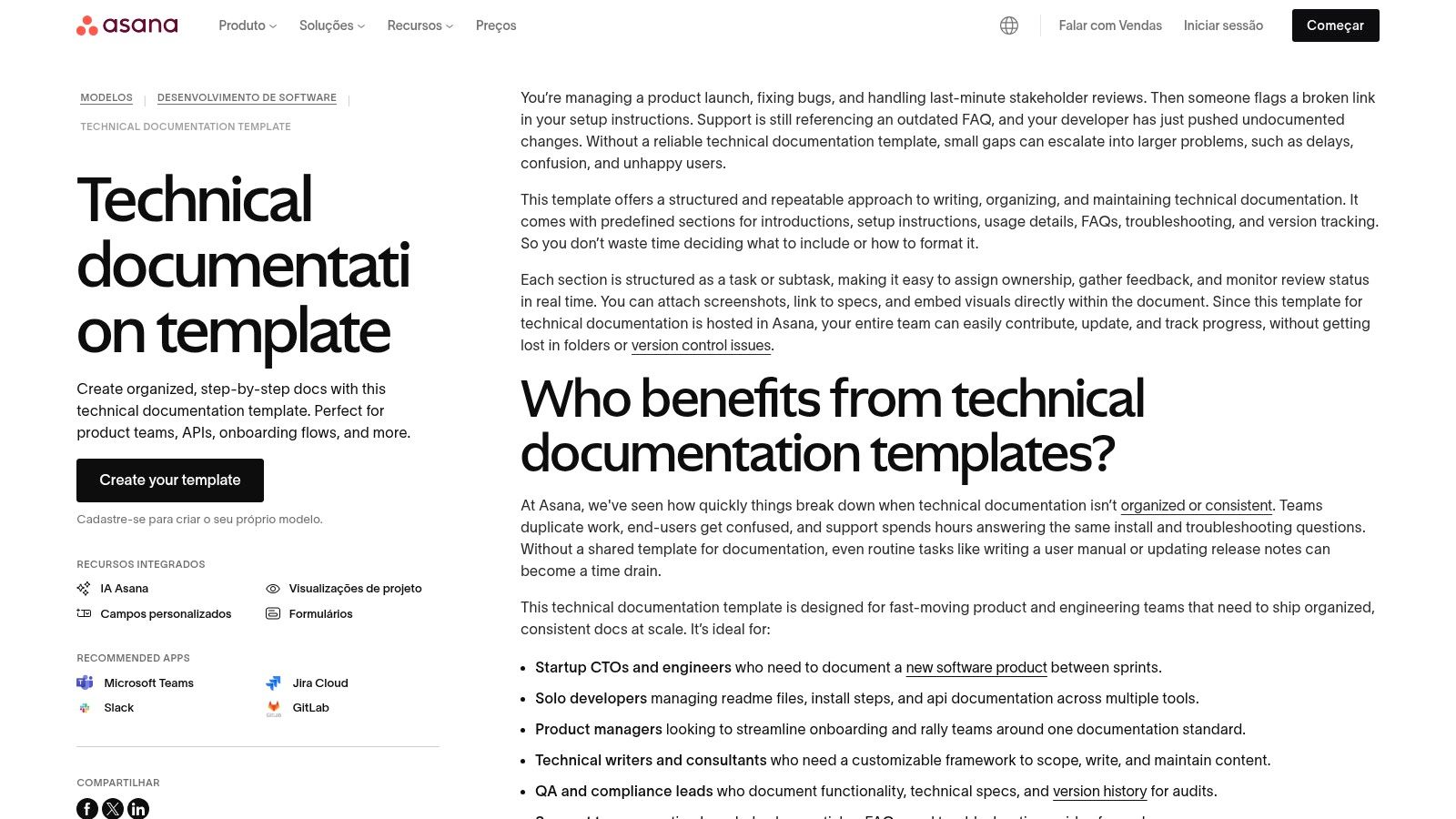
Asana’s template provides a solid, pre-built structure covering key areas like setup, usage, and troubleshooting. Its true value is realized through real-time collaboration, where team members can comment, assign tasks, and track progress directly within the documentation project. This is particularly effective in agile environments where documentation needs to evolve rapidly. For a deeper look into this approach, explore how documentation supports agile development.
Best For:
Implementation Note: Accessing the template requires a free or paid Asana account. While the interface is user-friendly, new users may face a slight learning curve understanding how to best leverage Asana’s project features for documentation purposes. It is more of a process framework than a traditional authoring tool.
Website: Asana Technical Documentation Template
ProProfs Knowledge Base offers a selection of free, structured technical documentation templates designed for teams aiming to build self-service help centers and user guides. Unlike tools that require complex setup, ProProfs provides ready-to-use frameworks that are immediately accessible online. The platform focuses on simplifying the creation of organized, user-friendly knowledge bases without needing deep technical expertise.
The main value proposition is its integration within the ProProfs ecosystem, which is centered around knowledge management and customer support. This makes it an excellent choice for teams that need to create documentation quickly and want a platform that can also handle FAQs, training materials, and customer support articles. The templates provide a solid foundation for structuring information logically.
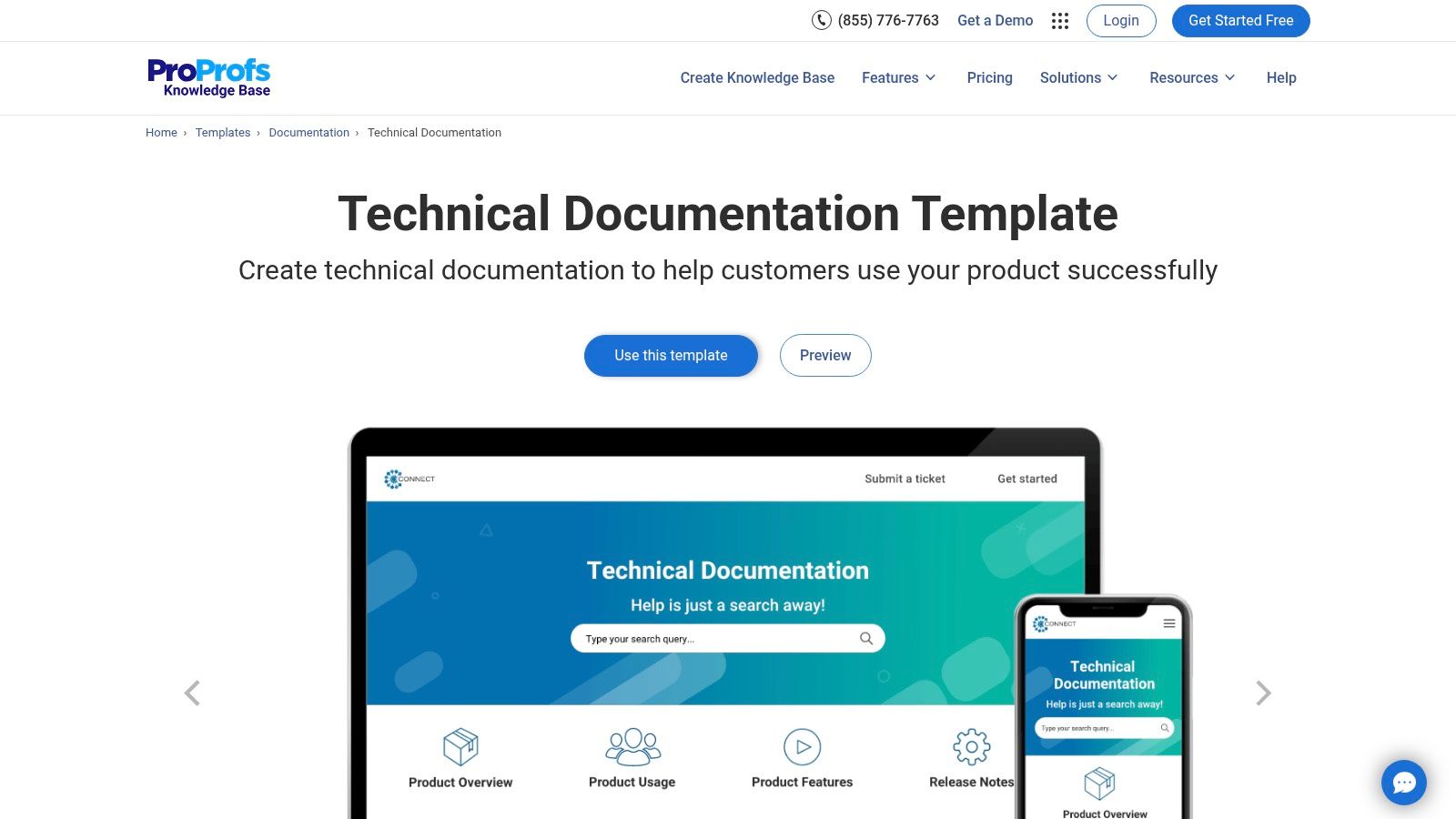
ProProfs’ templates are practical and functional, prioritizing ease of use and rapid deployment. They come with a predefined structure that guides you through creating sections for introductions, how-to guides, and troubleshooting, which is ideal for standard user manuals. The built-in responsive design ensures content is accessible on desktops, tablets, and mobile devices without extra configuration.